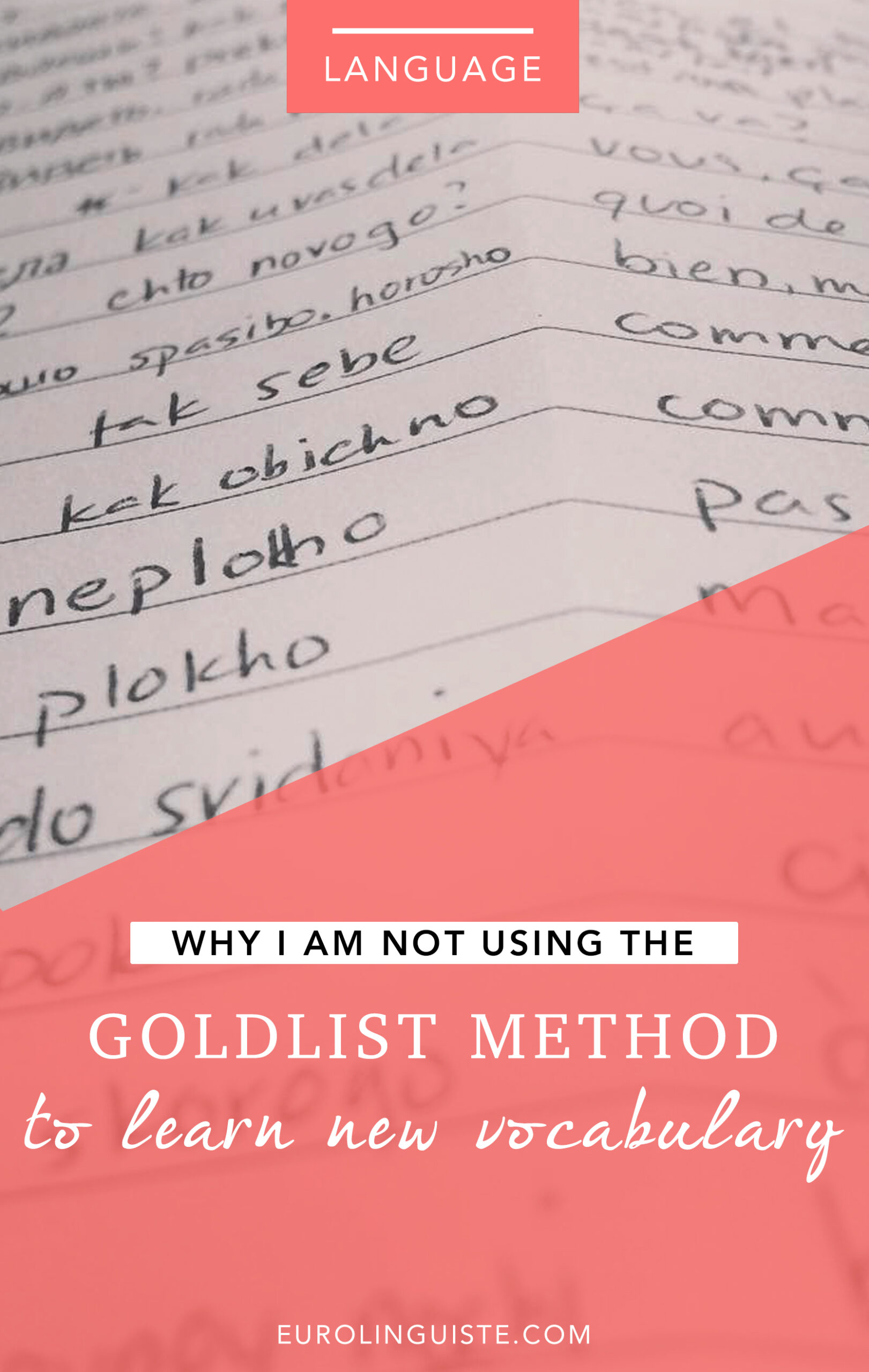Why I Am Not Using the Goldlist Method to Learn New Vocabulary

My name is Shannon Kennedy and I'm the language lover,…
A short while back, okay, maybe a little longer than that… I announced that the new (to me) language that I would be learning is Russian. I’m really excited about this language and it really was the first language that I started studying from scratch in more than a year (after my focus on Mandarin).
And that’s where this post comes in.
There have been quite a few posts going around amongst the language learning community on different memorization methods. I have been a huge supporter of SRS (spaced repetition) and it is what works for me. But I wanted to try something different just in case there might exist a method that works for me better than my current method.
That’s why I decided to give the Goldlist method a shot when learning Russian vocabulary.
I discovered the Goldlist method on this blog and then watched this video to learn how to use this learning method. I still take all my notes by hand, so I thought this might be a good method for me and it wouldn’t be that big of a change from what I’m already doing. It was only a matter of restructuring my notes. Or just some of my notes.
So, I gave myself three months to work on the Goldlist method, avoiding Memrise for Russian (my usual tool for vocabulary learning), in order to honestly evaluate my progress and the effectiveness of the Goldlist method on its own.
For those unfamiliar with the Goldlist Method, here’s a quick breakdown as I understood it.
How to Use the Goldlist Method
To start out using the Goldlist Method, you need a notebook, a pen and some time that you can set aside pretty regularly. Eventually, you’ll need several notebooks, but I’ll get to that in a bit.
The notebook needs to fit about 34 lines, so something small won’t really work for you. You need to be able to date each page at the top and fit in 25 words or phrases in your target language.
Now that we’ve covered what you’ll need, here’s a quick breakdown of how it works:
1 // On the back of the first page, write the date at the top and then number each line 1 through 25. Each line will be used for a word or phrase that you would like to remember.
2 // Fold the page in half (optional) so that you create two columns. On the left side, write the word or phrase in your target language. On the right side, write the word or phrase in your native language.
If you’re studying a language like Russian with a different writing system, you might want to consider creating three columns so that you can stick the transliteration of the word in the center column.
Remember that as you’re doing this, you’re not trying to *memorize* the words. You’re just enjoying the process of writing new vocabulary and their translations.
3 // When you finish your 25 words, take a break. That’s all you should complete in one session.
4 // If you want to get more study in, you’re not allowed to look at the previous list you just wrote. Instead, you can start a new page with another list of 25 words or phrases. If you choose to do this, simply turn the page and start the list on the back of page 2 in your notebook (leave the front blank!).
I would usually do one or two “headlists” (these are those initial lists of 25 words or phrases) per day.
5 // After two weeks (without looking at your previously written headlists), it’s time to distill. This is why it’s important to date each of your headlists so that you can keep track of when you need to return to them.
Using the fold you created earlier (or a sheet of paper to cover your list), hide the words in your target language from view so that you only see the list in your native language.
On the adjoining page, this is the front of page 2 that you left blank, number from 1 to 25 once more (just in case you need all 25 spaces) and date the page. Grab a separate sheet of paper and number from 1 to 25 there as well. Using the words you see in your native language as a prompt, try to write down the words that you remember on that separate sheet of paper. Any of the 25 words you can’t recall can now be written into that second page of your notebook.
By doing this, you’re trying to reduce the number of words on your list. Ideally, you want to remember about 8 words or phrases from what you wrote the last time around.
This second list is your first distillation.
6 // Repeat the above process for each of the headlists that you’ve created.
7 // After another two weeks have passed, you’re ready for your second distillation. Again, you’re trying to reduce that first distillation list, this time aiming to remove another 5 words (meaning you remember five of the words on this second list).
This second distillation should be written on the front of the second page, below the first distillation list (this is why you need a notebook that fits around 34 lines).
8 // Repeat the above process for each of the first distillation lists.
9 // After two *more* weeks, you’re ready for your third distillation! This list should end up with about 8 items. It is written on the back of the first page underneath the headlist.
10 // You can take it a step further and start a second notebook to continue distilling your word lists, but I’ll stop here for now.
A Note // The Goldlist Method has quite a few variations that exist amongst those who use this method. For example, rather than try to recall words by covering the target language translations, you can distill your lists by combining two words to create a short phrase for example “tall” and “man” as two entries can become one entry on the first distillation list as “tall man”. You can also distill be eliminating words that are no longer relevant to you.
You can also check out Chris Huff’s fun video game-like explanation of the Goldlist Method:
Why I Like the Goldlist Method
It’s a really great way to work on my penmanship for both the Cyrillic and Latin scripts.
I retain things better when I write them down. There’s a lot to be said for muscle memory.
The memory palace method is too abstract for me. I prefer things that are direct, minimalist and something else. This is exactly that.
I can work on words or phrases or conjugations or anything really. Even the alphabet. Memrise is often more word-based than not and so this method is really great for when I want to learn set phrases to use in conversation.
I get to pick the words that I learn. Rather than having to spend the time to create a Memrise deck or use one that’s already created (and having to learn the words in them whether I find them useful or not), I actually get to be incredibly selective about the words that go on my list.
It’s relaxing. There isn’t a timer that stresses me out like there is on Memrise. I don’t have to remember the word or spell it correctly within a certain time limit and it’s somewhat liberating.
Why I Won’t Continue to Use the Goldlist Method on Its Own
Even though I think it’s an incredible method and a great addition to my usual learning routine, I don’t learn as much vocabulary as quickly as I would like. It is rather time-consuming compared to other memorization techniques (for me, personally), so I will likely only continue to use it for really important phrases and go back to Memrise for words.
Single words aren’t as difficult to remember as entire sentences (for me at least), and so, I am definitely going to experiment with finding the right combination of flashcards and Goldlist learning to align my personal, learning preferences.
So that’s it for me. I’d really love to know more about how you learn new vocabulary in your target language. Please leave me a note in the comments below and I look forward to chatting with you!

My name is Shannon Kennedy and I'm the language lover, traveler, and foodie behind Eurolinguiste. I'm also the Head Coach of the Fluent in 3 Months Bootcamp, co-founder of Women in Language, and former Resident Polyglot at Drops.




